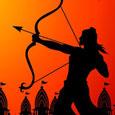|
It is an age-old religious belief that serpents are loved and blessed by Lord Shiva. He wears them as ornamentation around his neck. The most popular legend is about Lord Krishna and the snake called Kalia. Legend has it that the many-hooded Kalia and his brood settled in the eastern part of the Yamuna River next to the village of Brindavan. This had a negative impact on the surroundings as Kalia and his gang were venomous beings who poisoned the very ground they slithered on. Then one day, the little Lord Krishna arrived at the lakeside to play a ball game with his friends. While he was throwing the ball with his cowherd friends, it slipped into the waters and the little Lord jumped into the river waters to recover the ball. When Kalia tried to devour him, Krishna vanquished Kalia Serpent and saved the people from drinking the poisonous water by forcing Kalia to go away. Snakes have long been associated with many Hindu Gods. The thousand-headed Shesh Nag is the couch of Lord Vishnu. According to Hindu mythology, Lord Vishnu reclines on this couch to relax between the time of the dissolution of one Universe and creation of another. Devout Hindus believe earthquakes to be the reason of the shaking of Sheshnaga's head. Shesh Nag is also held to be the symbol of Eternity. Hindus believe in the immortality of the snake because of its habit of sloughing its skin. This is the reason why Eternity in Hinduism is often represented by a serpent eating its own tail. According to another legend, there once lived a Gavada Brahman in a city called Manikpura (or Maipura). He was ignorant of the Nagpanchami and did not know that no ploughing, digging, picking, burning or roasting should be done on this day. He therefore went to plough his field on the Nagpanchami day and accidentally killed the young ones of a female snake with his ploughshare. The female snake escaped death as she was absent during this time. When she returned and understood what had happened, she bit the Brahman and all his family-members to death. In her anger, she proceeded to kill the Brahman's sole surviving daughter who lived in another village. But when she found out that her intended victim was a devoted worshipper of the snake-goddess and had celebrated Nagpanchami that very day with great earnestness, she was greatly pleased. She not only spared her but on the daughter's insistence, gave her an ambrosia to sprinkle on the corpses of her recently deceased family members. The daughter did as she was directed and brought her family back to life. On her advice, the Gavada Brahman began to worship the Nagas (snakes) during Nagpanchami and vowed to refrain from ploughing or digging on the festive day. Following the Brahman, all men began to observe the Nagpanchami vrata(ceremony). This legend is believed to have set forth the origin of snake-worship in Western India. |

Ram Navami
Ram Navami Greetings and Images
Passover 2024
Passover Greeting Cards
Earth Day
Earth Day Greetings
May Day
Mother's Day
Multifaceted Lifestyle Blog
How to have a Great Date
|
|
 Ram Navami
Ram Navami Passover
Passover Good Morning
Good Morning